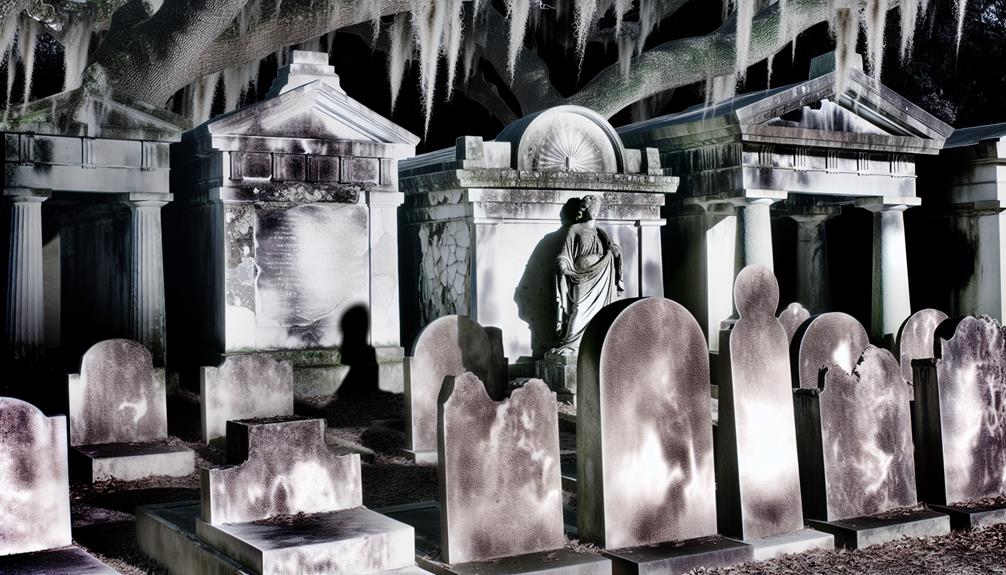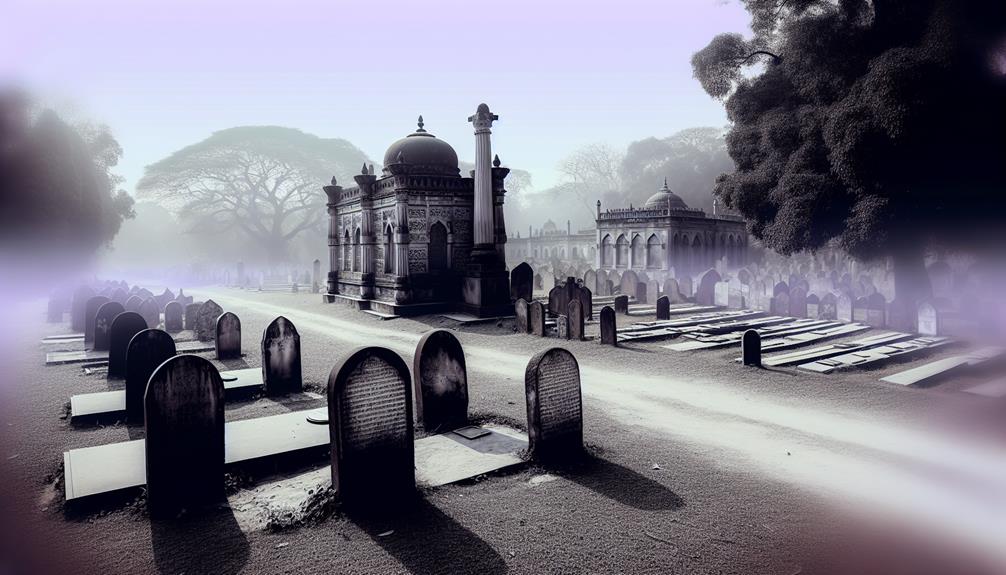Nestled within the vibrant city of New Orleans, St. Louis Cemetery exudes an air of mystery and historical significance. As visitors wander through its labyrinthine pathways, they are met with a visual feast of architectural wonders and cultural traditions that have withstood the test of time. The cemetery's intricate tombs and sacred spaces hold stories of both renowned figures and everyday individuals, each contributing to the tapestry of narratives waiting to be uncovered. This storied burial ground beckons exploration, offering a glimpse into a world where past and present intertwine seamlessly, leaving visitors intrigued and curious to discover more.
Key Takeaways
- St. Louis Cemetery is one of the oldest in New Orleans, established in 1789.
- The cemetery features above-ground burial practices due to the high water table.
- Notable figures like Marie Laveau and Homer Plessy are buried there.
- The cemetery showcases Gothic architecture and intricate tombstone symbolism.
- Visitors can explore through guided tours while respecting graveyard etiquette for a safe and educational experience.
History of St. Louis Cemetery
With a rich history dating back to the early 19th century, St. Louis Cemetery in the United States stands as a significant landmark with profound cultural and historical significance. The origins of St. Louis Cemetery can be traced back to the growing population of New Orleans in the early 1800s, leading to the need for more burial grounds. Established in 1789, it is one of the oldest and most famous cemeteries in New Orleans.
St. Louis Cemetery is renowned for its unique above-ground burial practices, a tradition influenced by the city's high water table. The practice of interring the deceased above ground in elaborate crypts and mausoleums is not only a practical solution to the city's burial challenges but also a reflection of the cultural heritage and traditions of the region. This distinctive burial method has made St. Louis Cemetery a notable site for those interested in funerary customs and historical cemetery architecture.
The cemetery's layout and design are a reflection of the historical evolution of burial practices and architectural styles in New Orleans. The intricate ironwork, impressive statues, and ornate tombstones found throughout the cemetery provide a glimpse into the cultural and social aspects of the time periods in which they were constructed. St. Louis Cemetery serves as a tangible link to the past, preserving the memory of generations past and offering a unique perspective on the city's rich history.
Notable Tombs and Graves
Among the array of impressive monuments and tombs that grace St. Louis Cemetery in the United States, several stand out for their historical significance and architectural splendor. One notable grave is that of Marie Laveau, the famous Voodoo priestess known for her spiritual powers and influence. Visitors often leave offerings at her tomb, adhering to the importance that making a small gift will grant them favors. Another prominent tomb is that of Homer Plessy, a key figure in the civil rights movement due to his role in the landmark Supreme Court case Plessy v. Ferguson.
Graveyard etiquette plays an important role in St. Louis Cemetery, with visitors expected to show respect for the deceased by refraining from loud conversations and refraining from touching or defacing the tombs. It is also customary to ask for permission before taking photographs out of respect for the privacy of those laid to rest.
The tombstone symbolism in St. Louis Cemetery is rich and varied, reflecting the diverse cultural influences present in New Orleans. From elaborate wrought-iron crosses symbolizing faith to angel statues representing protection, each tomb tells a unique story through its design and decorations. The intricate carvings and inscriptions on the tombstones often provide insight into the beliefs and values of the individuals buried there, creating a tapestry of history and heritage within the cemetery.
Architectural Features and Design
The architectural features and design of St. Louis Cemetery in the United States showcase a blend of historical influences and artistic craftsmanship that contribute to the cemetery's unique character and significance. The cemetery's structures exhibit elements of Gothic architecture, characterized by pointed arches, ribbed vaults, and flying buttresses, reflecting a style often associated with medieval cathedrals. These architectural choices evoke a sense of grandeur and timelessness, adding to the solemn atmosphere of the cemetery.
Symbolism plays a significant role in the design of St. Louis Cemetery, with intricate details adorning many of the tombs and mausoleums. Sculptures depicting angels, crosses, and other religious symbols are commonly found throughout the grounds, emphasizing the spiritual nature of the site. These artistic details not only showcase the skill and craftsmanship of the creators but also serve to honor and memorialize the deceased.
Craftsmanship is evident in the meticulous construction of the tombs and graves, with elaborate carvings, ornate ironwork, and intricate masonry work adorning many of the structures. The attention to detail in the design and execution of these features speaks to the dedication and reverence with which the cemetery was established and maintained over the years. Overall, the architectural features and design of St. Louis Cemetery reflect a rich history and a deep cultural significance that make it a truly remarkable place of remembrance.
Cultural Significance and Traditions
The Cultural Significance and Traditions surrounding St. Louis Cemetery in the United States are deeply intertwined with the historical fabric of the region, reflecting a rich tapestry of beliefs, customs, and practices.
- Voodoo Influence: The cemetery is known for its association with Voodoo practices, with many tombs adorned with symbols and offerings that are part of this unique cultural heritage.
- Above-Ground Burials: One of the most distinctive burial customs at St. Louis Cemetery is the prevalent use of above-ground tombs, reflecting both practical considerations due to the high water table in the region and a tradition that has become a hallmark of the site.
- Cultural Diversity: The cemetery serves as a demonstration to the diverse cultural practices and traditions that have shaped the region over the centuries, with influences from French, Spanish, African, and Creole cultures interwoven throughout the burial grounds.
These cultural practices and burial customs not only add to the historical significance of St. Louis Cemetery but also contribute to its unique atmosphere, drawing visitors from around the world to witness and learn about the rich tapestry of beliefs and traditions that are preserved within its gates.
Famous Figures Laid to Rest
Famous figures from various walks of life have found their final resting place within the historic grounds of St. Louis Cemetery, USA, adding a layer of significance to the site's cultural heritage. This cemetery is not merely a burial ground but a place where the legacies of renowned individuals are commemorated through their gravesites. The cemetery has become a significant destination for graveyard tourism, attracting visitors from around the world who come to pay their respects to these iconic figures.
St. Louis Cemetery is home to several celebrity memorials, with notable names such as Marie Laveau, the Voodoo Queen of New Orleans, drawing particular interest. Her elaborate tomb is a focal point for many visitors, intrigued by the mystique surrounding her life and the rituals performed at her gravesite. Additionally, the cemetery is the final resting place of Homer Plessy, whose landmark civil rights case, Plessy v. Ferguson, played an important role in the fight against segregation in the United States.
Graveyard tourism has gained popularity in recent years, with visitors exploring cemeteries not only for their historical significance but also for the chance to pay homage to famous individuals. St. Louis Cemetery stands out as a site where the memories of these famous figures are preserved, allowing visitors to connect with the past and appreciate the contributions of these iconic personalities.
Preservation Efforts and Challenges
Preservation initiatives at St. Louis Cemetery, USA, are essential for safeguarding its historical integrity and ensuring the conservation of its significant cultural heritage. The cemetery, with its rich history and unique architectural features, faces both preservation efforts and challenges in maintaining its authenticity and relevance.
Conservation Techniques: Implementing advanced conservation techniques is pivotal in preserving the aging structures and gravestones within the cemetery. These techniques involve specialized cleaning methods, structural reinforcement, and materials that are sensitive to the historical significance of the site.
Restoration Challenges: Overcoming restoration challenges such as weathering, vandalism, and natural decay is imperative to protect the cemetery's integrity. Finding solutions to restore damaged or deteriorating monuments while preserving their original design and historical value poses a significant challenge to preservation efforts.
Community Involvement, Fundraising Efforts: Engaging the local community in preservation activities and fundraising efforts plays a crucial role in ensuring the long-term sustainability of St. Louis Cemetery. By involving volunteers, raising awareness, and organizing fundraising campaigns, the community can contribute to the preservation and maintenance of this cultural landmark for future generations.
Balancing the need for conservation with the challenges of restoration, alongside fostering community involvement and fundraising efforts, is essential in safeguarding the historical and cultural significance of St. Louis Cemetery, USA.
Voodoo and Spiritual Practices
Exploring the intricate relationship between Voodoo and spiritual practices reveals a profound cultural tapestry woven within the context of St. Louis Cemetery, USA. The cemetery serves as a significant site for Voodoo rituals, attracting spiritual healers and practitioners seeking to connect with the energies of the deceased and the spirits believed to reside within the grounds.
Voodoo rituals conducted in St. Louis Cemetery often involve offerings to the cemetery spirits in exchange for guidance, protection, or assistance with personal matters. Spiritual healers, known as Houngans and Mambos, play a central role in facilitating these rituals and interpreting the messages from the spirit world. Visitors to the cemetery may witness these ceremonies taking place, offering a glimpse into the rich spiritual traditions intertwined with the history of the cemetery.
Furthermore, the paranormal investigations conducted in St. Louis Cemetery have shed light on the mysterious and supernatural elements present within its grounds. Many believe that the convergence of Voodoo practices and the burial site's history have contributed to reports of unexplained phenomena and ghostly encounters. These investigations add another layer of intrigue to the spiritual landscape of St. Louis Cemetery, inviting both believers and skeptics to explore its enigmatic depths.
Hauntings and Supernatural Legends
The lingering aura of mystery and the whispers of spectral encounters at St. Louis Cemetery, USA, have woven a tapestry of hauntings and supernatural legends that intrigue both visitors and researchers alike.
- Eerie Ghostly Encounters: Numerous visitors claim to have experienced ghostly encounters within the cemetery, reporting sightings of shadowy figures, unexplained footsteps, and cold spots. These encounters have fueled the cemetery's reputation as a paranormal hotspot.
- Mysterious Phenomena: Strange phenomena such as flickering lights, disembodied voices, and unexplained mists have been reported by visitors and paranormal investigators. These mysterious occurrences add to the allure of the cemetery and continue to pique the curiosity of those seeking answers.
- Legends of the Unexplained: Over the years, St. Louis Cemetery has become shrouded in legends of vengeful spirits, haunted tombs, and curses. These tales, passed down through generations, contribute to the cemetery's enigmatic atmosphere and draw thrill-seekers from far and wide.
The tales of ghostly encounters, mysterious phenomena, and unexplained legends surrounding St. Louis Cemetery serve as a magnet for those intrigued by the supernatural. Whether a skeptic or a believer, the cemetery's reputation as a hub of paranormal activity continues to captivate all who dare to explore its shadowy paths.
Guided Tours and Visitor Information
Guided tours at St. Louis Cemetery, USA, offer visitors an insightful and structured exploration of this historic site. As one of the most popular tourist attractions in New Orleans, the cemetery is known for its unique above-ground tombs and rich cultural history. These guided tours provide an opportunity for visitors to learn about the notable individuals buried here, such as Marie Laveau, the Voodoo Queen of New Orleans, and the city's diverse cultural influences.
When starting on a guided tour of St. Louis Cemetery, visitors are expected to adhere to certain cemetery etiquette guidelines. This includes showing respect for the deceased by refraining from touching or defacing the tombs, refraining from loud noises or disruptive behavior, and following the instructions of the tour guide. By abiding by these guidelines, visitors can make certain that they have a meaningful and respectful experience while exploring this historic site.
In addition to learning about the cemetery's history and notable residents, guided tours also provide visitors with valuable insights into the architectural styles of the tombs and the cultural practices surrounding death and burial in New Orleans. Whether you are a history enthusiast, a lover of architecture, or simply curious about the city's unique traditions, a guided tour of St. Louis Cemetery offers a fascinating glimpse into the rich tapestry of New Orleans' past.
Tips for Exploring Safely
For a safe and informative visit to St. Louis Cemetery, USA, it is essential to be mindful of certain precautions and guidelines. When exploring this historic site, consider the following tips:
- Stay on Designated Paths: St. Louis Cemetery is a maze of tombs and narrow walkways. To guarantee your safety and respect the resting places of the deceased, it is vital to stick to the designated paths provided.
- Avoid Wandering Alone: Due to the layout of the cemetery and its historical significance, it is recommended to explore in groups or with a guide. This ensures that you have assistance if needed and reduces the risk of getting lost.
- Carry Emergency Contacts: While exploring, it is wise to have a list of emergency contacts handy. In case of any unforeseen circumstances, having access to emergency numbers can help you quickly get assistance if needed.
Frequently Asked Questions
Can Visitors Participate in Any Rituals or Ceremonies at St. Louis Cemetery?
Visitors seeking cultural experiences and spiritual connections often inquire about participating in rituals or ceremonies at various sites of historical significance. Engaging in local traditions can provide a deeper understanding of the community's heritage and values.
However, it is essential to approach such activities with respect and sensitivity, ensuring that one follows any guidelines or restrictions in place to preserve the sanctity and authenticity of the rituals.
Are There Any Restrictions on Photography or Filming Within the Cemetery?
In various settings, regulations surrounding photography and filming are common to safeguard privacy, preserve sanctity, and maintain decorum. These restrictions often aim to balance the freedom of expression with the rights and sensitivities of individuals present.
By adhering to established guidelines, visitors can respectfully engage with their surroundings while honoring the significance and integrity of the space.
The implementation of such regulations underscores the importance of thoughtful consideration in capturing moments within restricted areas.
How Are New Burial Plots Allocated in St. Louis Cemetery?
In the allocation of new burial plots, various factors are considered, such as plot assignment processes and adherence to established burial customs and traditions.
The history of burial practices often influences how new plots are distributed, with some cemeteries following specific protocols rooted in cultural or religious beliefs.
Understanding these traditions is essential in ensuring that the allocation of burial plots respects the customs and values associated with the cemetery in question.
Are There Any Hidden or Secret Areas Within the Cemetery?
Hidden locations within cemeteries can often reveal intriguing tales and historical significance. Exploring such areas can expose secrets that spark curiosity and wonder among visitors.
When it comes to paranormal activity, these hidden spots may attract enthusiasts seeking encounters beyond the ordinary.
Understanding the allure of hidden or secret areas in cemeteries can provide a unique perspective on the complex relationship between history, spirituality, and the unknown.
Are There Any Specific Guidelines for Leaving Offerings at Gravesites?
When leaving offerings at gravesites, it is essential to follow specific guidelines, customs, and etiquette to show respect for the deceased and their families. Different cultural practices may dictate what types of offerings are appropriate and how they should be presented.
It is important to be mindful of these traditions and to act with sensitivity and reverence when leaving offerings at gravesites. Understanding and adhering to these customs can help maintain the sanctity of the burial grounds.
Conclusion
To sum up, St. Louis Cemetery in New Orleans is a compelling illustration of the city's rich history and cultural heritage.
With its unique above-ground burial practices, intricate architectural designs, and diverse spiritual traditions, the cemetery serves as a mesmerizing reflection of the past.
Like a tapestry woven with threads of history, belief, and memory, St. Louis Cemetery stands as a sacred and storied place that continues to intrigue and inspire visitors from around the world.


